
Illustrated Models -----
------- working this page
This modified cluster nuclear model can be characterized as
having a lattice structure built around those clusters.
The two dominant nuclear structures are
- the alpha particle.
- the nuclear carbon ring.
Be careful,
do not confuse the nuclear carbon ring with the chemical carbon ring.
As the nucleus grows several things will become very obvious.
- First, like nucleons (protons %amp; neutrons) are never
nearest neighbors in the nucleus, thus
- A proton can only have neutrons as nearest neighbors.
- A neutron can only have protons as nearest neighbors.
- Second, any four adjacent nucleons anywhere in the nucleus always
consists of
- two protons and two neutrons
- are always in the configuration of an alpha particle.
This model was built using the chart of nuclides. The stable nuclei occur along a diagonal line running through the chart. This diagonal line of stable nuclei form a feature referred to as the valley of stability. The connected stable nuclei form a path of stability along the valley of stability. The path of stability forms an instruction guide as to how the nucleus grows from one stable element or isotope to the next. This has been recognized in the past however the correct form and interactions of nucleons were not understood. Understanding that nucleons have a three sided form and the quarks at the corners control the structure form.
The color charge holds the entire structure together against the building positive electrical charge. The electrical charges of the quarks are arranged to further minimize the effects of the building positive charge. Understanding how these two forces work together to develop the nuclear structure finally revealed the structure of the nucleus.
To summerize
- The nucleus is composed of protons and neutrons each consisting of three quarks.
- The strong force holds the protons and neutrons in the nucleus,
- The color confinement holds the quarks in the protons and neutrons and
- The magnetic and electric fields of the quarks control the structure of the nucleus
- Three particle define a triangle in a single plane.
- Joining triangles along there edges forms a hexagonal structure.
- A hexagonal structure implies a base of six or multiples of six.
The hexagonal structure of the nucleus indicates that the nucleus grows in steps of six protons. Neutrons are added in even numbered quantities of six or more per step. Using this information a periodic table was constructed a copy of which can be found in the �Nuclear Periodic Table� section. Additionally nuclear growth tables were constructed which are included at various sections on the nucleus.
The Nuclear Growth Tables are explained in the "Stable Nuclei Growth Tables" section.
|
|
|
  This demonstrates how any four adjacent nucleons anywhere in the nucleus always consists of 2 protons and 2 neutrons and are always in the configuration of an alpha particle. Below is a map of the three stages of early core growth. This map is followed by ZOME models of each of these stages |
|
|
The carbon12 ring is the first stage of early core growth, but the carbon12 ring is the second completed nuclear structure, The first compled nuclear structure is the alpha particle. 

 





|